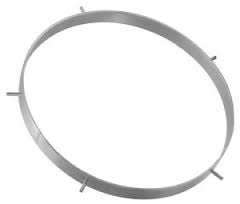Backing Ring
 A backing ring is a circular or annular metal piece used in welding to provide support and reinforcement to the root side of a weld joint. It is commonly used in applications where welding is performed from one side only, and the joint needs additional support to prevent the molten weld metal from flowing through the joint and to ensure proper fusion. A backing ring is inserted between two butt welding joints before welding to allow for complete penetration. During the welding the molten metal will expand the ring and force it against the pipe eliminating gaps in the weld.
A backing ring is a circular or annular metal piece used in welding to provide support and reinforcement to the root side of a weld joint. It is commonly used in applications where welding is performed from one side only, and the joint needs additional support to prevent the molten weld metal from flowing through the joint and to ensure proper fusion. A backing ring is inserted between two butt welding joints before welding to allow for complete penetration. During the welding the molten metal will expand the ring and force it against the pipe eliminating gaps in the weld.
Backing rings are especially common in situations involving groove welds or butt welds, where the components to be welded are aligned edge-to-edge. The backing ring is positioned on the root side of the joint, and the welding is performed from the opposite side, often referred to as the "face side" of the joint.
Key Points about Backing Rings
Function - The primary purpose of a backing ring is to maintain proper root spacing and to prevent the weld metal from passing through the joint, which can lead to incomplete penetration.
Types - Backing rings come in various shapes, sizes, and materials to suit different applications. They can be made of carbon steel, stainless steel, or other alloys.
Preventing Burn-through - When welding thicker materials, the high heat input required for proper fusion can sometimes cause burn through (melting through) the root side. A backing ring helps dissipate the heat and prevents burn-through.
Fusion and Penetration - The backing ring assists in achieving complete fusion and penetration on the root side of the joint, contributing to the overall strength of the weld.
Reducing Weld Defects - By providing a controlled environment for the molten weld pool, backing rings help reduce the likelihood of defects like lack of fusion or excessive penetration.
Removable or Consumable - Some backing rings are designed to be removed after welding, while others are intended to be a permanent part of the welded structure.
Application - Backing rings are commonly used in industries like shipbuilding, construction, pipelines, and pressure vessel fabrication.
Process of Welding with a Backing Ring
It's important to note that while backing rings can be very useful, they also require proper placement and fit-up to ensure the desired welding results. The appropriate size and type of backing ring should be chosen based on the specific welding application and material being used. Additionally, the selection of the welding process and parameters should be done with consideration for the presence of the backing ring to achieve a high quality weld.
Key Points about Welding Process for Backing Ring
Preparation - Select a suitable backing ring based on the material being welded, the welding process, and the joint design. Clean the backing ring to remove any contaminants, rust, or debris that could affect the weld quality.
Fit-up - Align the components to be welded, ensuring that they are properly spaced and centered. Position the backing ring on the root side of the joint, ensuring that it is centered and properly seated.
Tack Welding - Use tack welds to secure the backing ring in place. Tack welds are small, temporary welds that hold the components and backing ring together before the final weld is applied.
Welding - Begin the welding process from the opposite side of the backing ring, often referred to as the "face side" of the joint. The heat and weld metal flow will be directed towards the backing ring and root side of the joint.Proper technique and welding parameters should be used to ensure complete fusion and penetration of the root side.
Control Heat Input - Backing rings help distribute the heat and prevent excessive penetration or burn-through on the root side. Controlling the heat input is crucial to prevent overheating the backing ring or causing defects in the weld.
Filler Metal and Electrode - Use appropriate filler metal or electrode for the specific welding process and material being joined. Proper technique, angle, and travel speed are important to ensure consistent and sound welds.
Quality Control - Inspect the completed weld for defects such as lack of fusion, incomplete penetration, or excessive reinforcement. Verify that the root side of the joint is properly fused and the backing ring is securely attached.
Post-weld Treatment - Depending on the application and material, post-weld treatments like stress relieving or heat treatment might be necessary to ensure the stability and strength of the welded joint.
Welding with a backing ring is a technique used to achieve complete fusion and penetration in applications where welding from both sides of the joint is not feasible or practical. The use of backing rings requires proper preparation, fit-up, and welding techniques to ensure a high quality and reliable weld joint.

